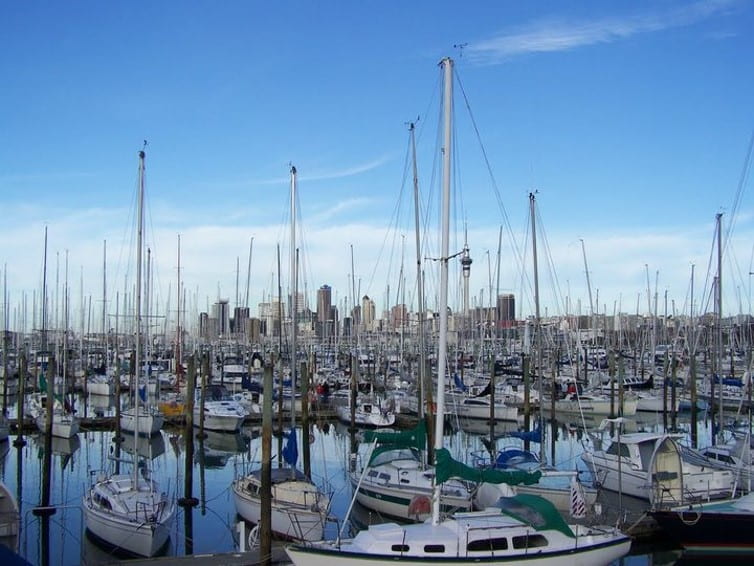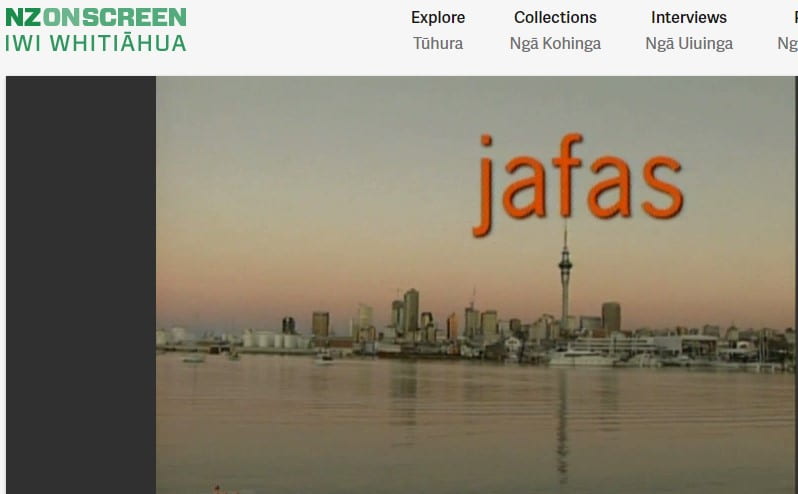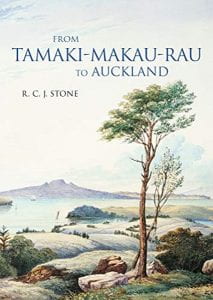by Linda Bryder*
In July 2021 I was invited to speak at an urban history symposium in Palmerston North about the history of ‘Auckland: The Big Smoke’. Auckland has always been my home; my parents arrived in Auckland in 1950 as Danish immigrants, after a brief sojourn in Taranaki. While I appreciate the term ‘Big Smoke’ is a generic term for metropolitan spaces,[i] I like to think of ‘my’ city differently. Admittedly as a young adult in 1976 I chanced to stay with a family on a farm in Oamaru during a trip around the South Island who described Auckland as ‘The Big Smoke’, so I guess I had to accept that at least some, and probably many, outside Auckland saw it that way. Yet it is far from the only nomenclature the city has experienced through time.
In 1980 I did an MA thesis on the 1918 influenza epidemic in Auckland, which taught me a lot about Auckland at the end of the First World War.[ii] I found Auckland described somewhat surprisingly as ‘The Garden City’, a term I always thought reserved for Christchurch. The article in the Auckland Star was headed ‘The Housing Problem’, which sounds uncomfortably familiar to modern Aucklanders, but the article proceeded:
To describe Auckland as some of our Southern cities have done as a ‘slum’ city is an outrageous calumny. Nothing has ever impressed strangers and visitors from other countries more strongly in Auckland than our bountiful provision of public reserves and recreation areas. One distinguished public official from Australia, in a report on civic and municipal conditions, has described Auckland tersely as ‘a city of parks’, another to whom Sydney and Melbourne and Adelaide are well known, has termed it ‘the garden city of Australasia’.[iii]
The name which eventually stuck, however, was ‘the Queen City’. For instance, the title of a 1953 history was The Auckland Story: New Zealand’s Queen City and its Citizens through the years. The author cited the Union Steamship Company which described Auckland in 1884 as ‘the Naples of New Zealand’ and claimed that ‘no other town in the Colony [was] able to approach it in the beauty of its many sea views’. It enthused, ‘On landing and exploring the different parts of the city, the beauty of its situation unfolds itself at every step.’ This was in the 1880s but the book’s author believed it still relevant to the 1950s, describing Auckland then as: ‘A city supreme of a country of fine cities’. His dedication reveals the optimism of the 1950s, where he wrote, ‘May we not fail or falter in the task yet to come to build a still greater and even more beautiful city.’[iv]
Skipping to modern times, Auckland was designated the ‘City of Sails’ by its Council in 1985, owing to its staggering number of boats – apparently one boat for every three households.[v] The Council dropped this title in 2008, probably because of the elite sound of it, adopting in its place ‘World’s Most Liveable City’ in 2010. One article on this development quipped, ‘Aucklanders everywhere were cheered by this cheeky little slogan even as they huddled in their damp, uninsulated rentals, waited for trains that perhaps never existed in the first place, and watched [then mayor] Len Brown glide around town in his limo.’[vi]
More critical times were upon us, and perhaps the most damning of all was the new term for Aucklanders themselves, JAFAS. This was not a reference to the orange and chocolate lollies we used to roll down the aisles at picture theatres. Rather, it is short for ‘Just another F’ing Aucklander’, although a book by Auckland sociologists in 2004 called Almighty Auckland suggested it was short for ‘Just Another Friesian Aucklander’, in reference to the dairy farming in Auckland’s hinterland.[vii]
In 2000 JAFAS became the subject of a TV documentary, when Cantabrian Joe Bennett decided to investigate the views of South Islanders about Auckland, and, as he put it, he went on a JAFAS hunt. The view of one South Islander recorded for the documentary was: ‘Aucklanders? Well they’re not really part of New Zealand, are they? They’ve got their little culture, their own little country up there.’ An article on our AHI website pointed out that this documentary was filmed ten years before Auckland became a ‘SuperCity’, when eight separate city councils were incorporated into a larger and unified Auckland.[viii] Before this merger, suburbs from the far outskirts of the city centre (such as Henderson, Otara, Albany and Papakura) belonged in their separate cities and districts. So, when participants of the documentary talked about the ‘Aucklander’, they were perhaps referring to those living in what was then known as ‘Auckland City’, now called the CBD. After regions of different demographics and backgrounds came together, it was perhaps more difficult to imagine an archetypal ‘Aucklander’, although I doubt this would have deterred those south of the Bombay Hills from doing so.
But now the common nomenclature is Tāmaki Makaurau, used on a daily basis in, for instance, TV news and weather bulletins. This name is of course not new. In 2002 Professor Russell Stone published his monumental book From Tamaki-Makau-Rau to Auckland, covering the isthmus between the two harbours on which modern Auckland stands and which Māori called Tāmaki-makau-rau (Tāmaki-desired-by-many, owing to its natural resources and geography).[ix] This area was, he explained, a virtual population void when Captain William Hobson bought it in 1840 from the resident owners as the site of his new capital, but had been reputed in former times to be the most densely settled region in Aotearoa, and in his book Stone explored its transition over 800 years. In 2002 Tāmaki Makaurau was adopted as the official name of the northern part of the Hauraki electorate. Since then with the heightened interest in adopting te reo as a mainstream language in Aotearoa, it has become the accepted name for Auckland, with both used interchangeably, and has become the identity for the three Auckland Districts of Waitematā, Auckland City and Counties Manukau.
During COVID and lockdown, when Auckland was isolated from the rest of the country, it was known as the ‘engine-room of the country’s economy’.[x] This was not entirely new either; already in 2012 it was publicly described as the ‘country’s economic engine room’.[xi] Good to know we have our uses. The rest of the country continues to have a love-hate relationship with Auckland but what stands out here is a history of civic pride amongst those living in Auckland – or whatever we wish to call it. How the rest of the country will survive the invasion of Aucklanders once borders reopen remains to be seen.
December 2021
*Linda Bryder is a Professor in History at the University of Auckland.
[i] Ben Schrader, The Big Smoke: New Zealand Cities, 1840–1920, 2016 Bridget Williams Books, Wellington.
[ii] L. Bryder, ‘The 1918 Influenza Epidemic in Auckland’, University of Auckland, 1980.
[iii] The Housing Problem, Auckland Star, 19 November 1918.
[iv] John Grainger, The Auckland Story: New Zealand’s Queen City and its Citizens through the years, Wellington, AH & AW Reed, 1953; dedication and pp. 82, 98.
[v] Bassett, Michael, City of Sails: The History of Auckland City Council 1989-2010, Auckland City Council, Auckland, 2013.
[vi] A history of Auckland’s slogan identity crisis, 19 November 2016; https://www.rnz.co.nz/news/the-wireless/374343/a-history-of-auckland-s-slogan-identity-crisis.
[vii] Ian Carter, David Craig and Steve Matthewman (eds), Almighty Auckland? Dunmore Press, Palmerston North, 2004.
[viii] Kyra Maquiso, JAFAS: Just Another F*****g Annoying Stereotype?
[ix] R.C.J. Stone, From Tamaki Makau-rau to Auckland, Auckland University Press, 2002.
[x] For example: Auckland Business Chamber, Keeping the engine room of the economy humming, 8 September 2020, https://aucklandchamber.co.nz/2020/09/08/keeping-the-engine-room-of-the-economy-humming/
[xi] ‘NZ’s engine room in need of a rev up’, NZ Herald, 14 April 2012, https://www.nzherald.co.nz/business/nzs-engine-room-in-need-of-a-rev-up/FBAFUKVP4FH3QBUDBFYUQQT5EY/




